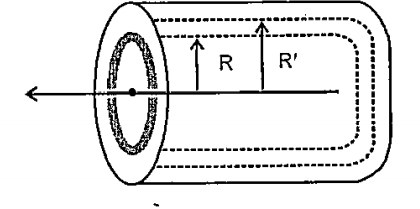Figure shown a long solid cylinder of radius R, inside a long hollow tube of linner radius R',.A viscous liquid of coefficient of viscosity η is fillied in the gap between the cylinder and the hollow tube. If the soild cylinder is moved with velocity v parallel to its lenght inside the fixed hollow tube, find the force required per unit lenght to be applied on the solid cylinder, assuming uniform velocity gradient in the liquid

η(2πR')(vR'−R)
η(2πR)(vR'−R)
η(4πR')(vR'+R)
η(4πR')(vR'+R)
The correct Answer is:B
Topper's Solved these Questions
Similar Questions
Knowledge Check
Moment of inertia of a hollow cylinder of mass M and radius R, about the axis of cylinder is
A12MR2BMR2C23MR2D25MR2
A long charged cylinder of linear charge density λ is surrounded by a hollow co-axial conducting cylinder. What is the electric field in the space between the two cylinders ?
View SolutionA long charged cylinder of linear charged density à is surrounded by a hollow co-axial conducting cylinder. What is the electric field in the space between the two cylinders ?
View SolutionA long charged cylinder of linear charge density λ is surrounded by a hollow co-axial conducting cylinder. What is the electric field in the space between the two cylinders ?
View SolutionFind the moment of inertia of a solid cylinder of mass M and radius R about a line parallel to the axis of the cylinder and on the surface of the cylinder.
View SolutionFind the moment of inertia of a solid cylinder of mass M and radius R about a line parallel to the axis of the cylinder and on the surface of the cylinder.
View SolutionA long charged cylinder of linear charge density λ surrounded by a hollow co-axial conducting cylinder. What is the electric field in the space between the two cylinders?
View SolutionA long cylinder of radius R1 is displaced along its axis with a constant velocity v0 inside a stationary co-axial cylinder of radius R2. The space between the cylinders is filled with viscous liquid. Find the velocity of the liquid as a function of the distance r from the axis of the cylinders. The flow is laminar.
View Solution
